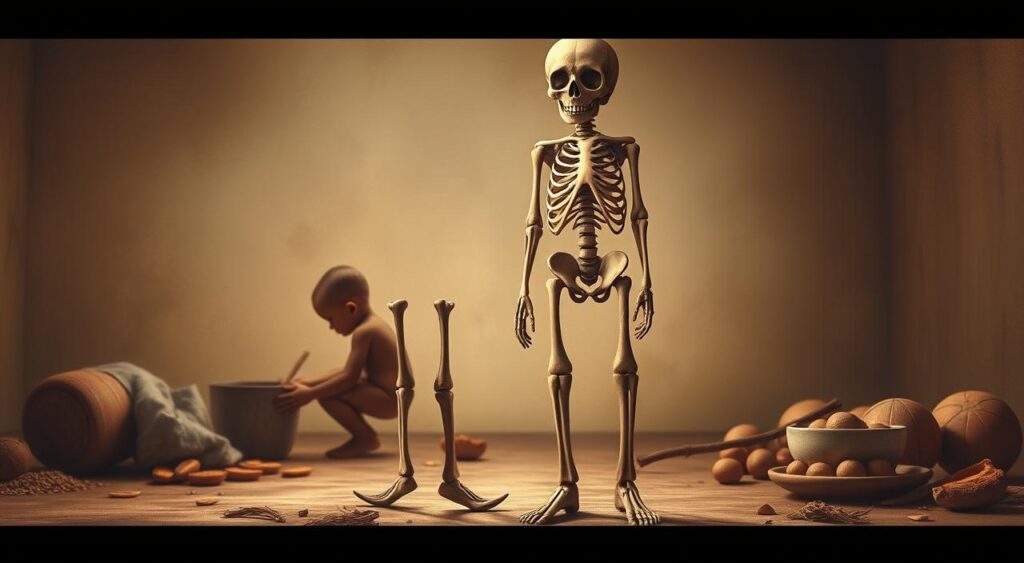Discover the key symptoms, underlying causes, and proven treatments for rickets, a bone disease caused by vitamin D deficiency.
Over 1 billion people worldwide lack enough vitamin D, leading to rickets. This bone disease causes soft and weak bones in kids. It’s linked to a lack of vitamin D, calcium, or phosphate. If not treated, it can have serious effects.
Rickets can be stopped and treated with vitamin D supplements, better diet, and medical care. It’s key to know the signs, causes, and treatments for rickets. Also, understanding vitamin D’s role in bone health is crucial.

Key Takeaways
- Rickets is a bone disease caused by vitamin D deficiency, affecting millions of people worldwide.
- Vitamin D plays a crucial role in bone development and preventing rickets.
- Early diagnosis and treatment can prevent long-term effects of rickets.
- Dietary changes and vitamin D supplementation can help prevent and treat rickets.
- Understanding the symptoms and causes of rickets is essential for effective management and prevention.
- Rickets can have severe consequences if left untreated, making prompt medical attention critical.
- Prevention methods, such as sun exposure and dietary guidelines, can help reduce the risk of developing rickets.
Understanding Rickets: An Overview
Rickets is a bone disease that affects children and adults. It causes softening of the bones due to a lack of vitamin D. Symptoms include bowed legs, stunted growth, and bone pain. The main causes are a lack of vitamin D, calcium, or phosphate.
Rickets has been a big health problem for a long time. It was a big issue in ancient times and still is today. It’s especially common in places where people don’t have access to good food and healthcare.
What is Rickets?
Rickets affects the bones of children and adults. It’s caused by not having enough vitamin D. This vitamin is key for absorbing calcium and growing bones. Without it, people can have bowed legs, stunted growth, and a higher risk of breaking bones.
Historical Background
Rickets has been around for thousands of years. It was mentioned in ancient Egyptian and Greek texts. In the 17th and 18th centuries, it was a big problem in Europe, especially in cities where people didn’t get much sunlight or eat well.
Global Prevalence
Today, rickets is still a big issue worldwide. The World Health Organization says millions of people lack vitamin D, leading to rickets. It’s most common in places where healthcare, food, and sunlight are scarce.
It’s important to know the symptoms of rickets and causes of rickets to treat it well. Doctors can spot the signs early and start treatment. This helps prevent serious health problems later on.
Common Signs and Symptoms of Rickets
Rickets is a disease that affects bone development in children. It can cause a range of symptoms, from mild to severe. Early diagnosis and treatment for rickets are key to preventing long-term problems and ensuring bones grow right.
Common signs include bowed legs, stunted growth, and muscle weakness. In severe cases, rickets can cause bone deformities and fractures. It’s important to see a doctor if symptoms don’t go away.
To prevent rickets, a balanced diet, sun exposure, and supplements are important. Foods rich in vitamin D and calcium help keep bones strong.
- Maintaining a healthy diet that includes foods rich in vitamin D and calcium
- Ensuring adequate sun exposure to promote vitamin D production
- Following supplementation protocols as recommended by a healthcare professional
Understanding rickets symptoms and preventing it is crucial for children’s bone health. Early treatment can prevent serious issues and ensure a child’s health and well-being.
| Symptom | Description |
|---|---|
| Bowed legs | Abnormal curvature of the legs |
| Stunted growth | Slowed or delayed growth and development |
| Muscle weakness | Reduced muscle strength and endurance |
The Role of Vitamin D in Bone Development
Vitamin D is key for bone health. It helps prevent childhood disease like rickets. Without enough vitamin D, bones can’t grow right and rickets risk goes up.
Vitamin D Metabolism
Vitamin D turns into its active form through metabolism. This active form controls how the body absorbs calcium and keeps phosphate levels balanced.
Calcium Absorption
Calcium is vital for strong bones. Vitamin D helps the body take in calcium from food. This calcium is then used to strengthen bones.
Phosphate Balance
Phosphate balance is also key for bones. Vitamin D helps keep phosphate levels healthy in the body.
Knowing how vitamin D affects bone growth is crucial. It helps prevent and treat rickets. Keeping vitamin D levels right can lower the risk of this childhood disease and boost bone health.
| Vitamin D Sources | Food Sources | Benefits |
|---|---|---|
| Sunlight | Fatty fish, fortified dairy products | Maintains bone health, prevents childhood disease |
| Supplements | Fortified cereals, orange juice | Supports calcium absorption, regulates phosphate balance |
Risk Factors Associated with Rickets
Rickets is a disease caused by vitamin d deficiency, not enough sun, and a diet lacking calcium and phosphate. Medical issues like celiac disease and kidney disease also raise the risk.
Some key risk factors for rickets include:
- Living in areas with little sunlight, leading to vitamin d deficiency
- Eating a diet low in calcium and phosphate
- Having certain medical conditions, like celiac disease or kidney disease
- Being of African or Asian descent, as these groups are more at risk
Knowing these risk factors helps us take steps to prevent rickets. Eating well and keeping vitamin d levels up can help avoid this disease.
By understanding rickets risk factors and acting early, we can prevent it. This helps keep our bones strong.
| Risk Factor | Description |
|---|---|
| Vitamin D deficiency | Lack of enough vitamin D in the body |
| Limited sun exposure | Not getting enough sunlight, which can cause vitamin D deficiency |
| Inadequate dietary intake | Eating too little calcium and phosphate |
Diagnosis and Medical Assessment
Diagnosing rickets requires a physical exam, blood tests, and bone X-rays. These steps help spot the signs of rickets and figure out why it happens. A physical check can show bone deformities and muscle weakness, common in rickets. This first step is key to knowing if someone has rickets and how bad it is.
A detailed medical check includes blood tests to find low vitamin D and calcium levels. These are vital for bone health. The blood test results show if a vitamin D or phosphate problem is causing rickets. Also, bone X-rays confirm rickets and show how severe it is. This helps doctors act quickly.
- Physical exam findings, like bone deformities and muscle weakness
- Blood test results, showing vitamin D and calcium levels
- Bone X-ray results, which confirm rickets and its severity
Understanding rickets symptoms and causes helps doctors create good treatment plans. This way, they can manage the condition and avoid serious problems later on.
Different Types of Rickets
Rickets is a disease with various forms, each with its own causes and symptoms. Knowing these types is key for effective treatment for rickets and prevention of rickets. The main types include:
- Nutritional rickets, caused by a lack of vitamin D and calcium in the diet
- Vitamin D-resistant rickets, a condition where the body is unable to respond to vitamin D
- Hypophosphatemic rickets, characterized by low phosphate levels in the blood
Each type needs a specific approach to treatment for rickets and prevention of rickets. Knowing these types well is vital for effective management and prevention.

By understanding the different types of rickets and their causes, people can take steps to prevent it. They can also seek the right treatment for rickets if symptoms show up.
| Type of Rickets | Cause | Symptoms |
|---|---|---|
| Nutritional Rickets | Lack of vitamin D and calcium | Softening of bones, bowed legs |
| Vitamin D-Resistant Rickets | Body’s inability to respond to vitamin D | Seizures, muscle weakness |
| Hypophosphatemic Rickets | Low phosphate levels | Growth retardation, bone pain |
Treatment Options and Medical Interventions
Treating rickets needs a detailed plan to fix the disease’s root causes. This plan focuses on making bones stronger. It usually includes giving vitamin D and making sure the diet has enough calcium and phosphate.
It’s key to keep an eye on how the treatment is working. A doctor will create a treatment plan that fits the patient’s needs. This plan considers how bad the disease is and the patient’s health.
- Vitamin D supplementation to restore normal vitamin D levels
- Dietary changes to ensure adequate intake of calcium and phosphate
- Medical monitoring to assess the effectiveness of treatment and prevent long-term complications
With the right treatment and a doctor’s help, people with rickets can manage their condition. They can also improve their bone health. This reduces the chance of serious problems later on.
Preventing Rickets in Children
It’s important to prevent rickets in kids to help them grow strong bones. Rickets happens when kids don’t get enough vitamin D. This can make their bones soft and weak, leading to health problems.
Parents should give their kids a diet full of vitamin D and calcium. Foods like fatty fish, egg yolks, and fortified dairy products are good. Also, some sun exposure helps the body make vitamin D, which is key for bone growth. But, it’s important to not get too much sun to avoid skin cancer.
Dietary Guidelines
To stop rickets, follow these diet tips:
- Eat foods rich in vitamin D, like fatty fish, egg yolks, and fortified dairy products
- Choose foods high in calcium, such as milk, cheese, and leafy greens
- Try to avoid sugary and processed foods that can block vitamin D and calcium
Supplementation Protocols
Some kids might need vitamin D supplements to avoid rickets. The American Academy of Pediatrics suggests giving all infants and kids 400 IU of vitamin D daily, starting at birth. Always talk to a doctor before starting any supplements to make sure the dose is right and to watch for side effects.
By following these diet and supplement tips, parents can help their kids avoid rickets. Regular doctor visits are also key to catch any vitamin D or rickets problems early.
Long-term Effects of Untreated Rickets
Untreated rickets can severely harm your health, especially your bones. The symptoms of rickets can cause bone deformities, stunted growth, and a higher risk of osteoporosis. Knowing the causes of rickets is key to preventing and treating it.
Some long-term effects of untreated rickets include:
- Bone deformities, such as bowed legs or curved spines
- Stunted growth, resulting in shorter stature
- Increased risk of osteoporosis, which can lead to fractures and osteoarthritis
It’s vital to spot the symptoms of rickets and tackle the causes of rickets to avoid these effects. Early treatment can greatly improve outcomes for those with rickets.

Understanding the long-term effects of untreated rickets helps you take action. This ensures a healthier, more active life.
Living with Rickets: Lifestyle Modifications
Managing rickets needs a full plan that includes daily habits, exercise, and food. Eating foods rich in calcium and phosphate is key for strong bones. Regular exercise, like walking or swimming, helps improve bone health.
For good treatment for rickets, team up with a doctor to make a plan just for you. This might include vitamin D pills, changing your diet, and checking your bones often. Making smart choices in your lifestyle can lower the risk of problems and boost your life quality. Prevention of rickets is also key, done through diet changes, sunlight, and supplements.
- Maintain a balanced diet rich in calcium and phosphate
- Engage in regular exercise, such as walking or swimming
- Avoid activities that may exacerbate the disease
- Work with a healthcare provider to develop a personalized treatment plan
By changing your lifestyle and working with a doctor, you can manage rickets well. A detailed plan for prevention of rickets and treatment for rickets is vital for strong bones and health.
| Strategy | Benefits |
|---|---|
| Dietary modifications | Improved bone density, reduced risk of complications |
| Regular exercise | Improved bone health, increased overall well-being |
| Vitamin D supplementation | Improved bone density, reduced risk of rickets |
Special Considerations for Different Age Groups
Rickets is a disease that affects bones and can happen to anyone, but it’s more common in kids. It’s important to watch and treat children and teens to avoid serious problems later.
Here are some important things to think about for different ages:
- Infants and toddlers: breast milk or formula with vitamin D to help bones grow strong.
- Children and adolescents: eat foods rich in calcium and phosphate. Also, get enough sunlight to help bones develop.
- Adults: manage health issues like kidney or liver disease to stop rickets from getting worse.
By considering these points, people can help prevent or treat rickets. This keeps bones healthy at any age.
It’s crucial to catch rickets early to avoid lasting damage to bones. This shows why quick diagnosis and treatment are key.
Conclusion: Managing and Preventing Rickets Effectively
The best way to handle and stop rickets is through a mix of vitamin D supplementation, changing what we eat, and keeping an eye on our health. Knowing what causes rickets and spotting its early signs helps us protect our bones. This way, we can avoid the serious problems that come with it.
It’s very important to get enough vitamin D. This can be from the sun or supplements. It helps keep calcium and phosphate levels right for strong bones. Eating foods full of calcium, phosphorus, and other nutrients also helps our bones grow and get stronger.
Spotting rickets early and treating it fast is key. Regular visits to the doctor, including physical checks, blood tests, and X-rays, help catch it early. This makes it easier to start treatment right away.
Teaching people how to prevent and manage rickets helps everyone stay healthy and active. It keeps us away from the bad effects of this avoidable disease. Let’s make a world where rickets is just a memory. Where every child can grow up with strong, healthy bones.
FAQ
Q: What is rickets?
A: Rickets is a bone disease that affects children and adults. It’s caused by a lack of vitamin D. This leads to soft bones and skeletal deformities.
Q: What are the common symptoms of rickets?
A: Symptoms include bowed legs, stunted growth, and muscle weakness. Bone pain and delayed tooth development are also signs.
Q: What causes rickets?
A: Vitamin D deficiency is the main cause. It’s needed for calcium and phosphate absorption. Limited sun, poor diet, and some medical conditions also play a role.
Q: How is rickets diagnosed?
A: Doctors use physical exams, blood tests, and X-rays. These help check vitamin D, calcium, and phosphate levels and bone health.
Q: How is rickets treated?
A: Treatment involves vitamin D supplements and a diet rich in calcium and phosphate. Regular check-ups are also key.
Q: How can rickets be prevented?
A: Prevention includes getting enough vitamin D from sun, diet, or supplements. A balanced diet and regular health checks are also important.
Q: What are the long-term effects of untreated rickets?
A: Untreated rickets can cause severe bone deformities and stunted growth. It also raises the risk of fractures, osteoarthritis, and osteoporosis.
Q: How can individuals with rickets manage their condition?
A: Daily management includes a balanced diet and exercise. Regular health check-ups are crucial to monitor progress and adjust treatment.
Q: Are there any special considerations for different age groups with rickets?
A: Yes, treatment varies by age. Children and teens need close monitoring to prevent complications. Adults may need to address underlying conditions.
